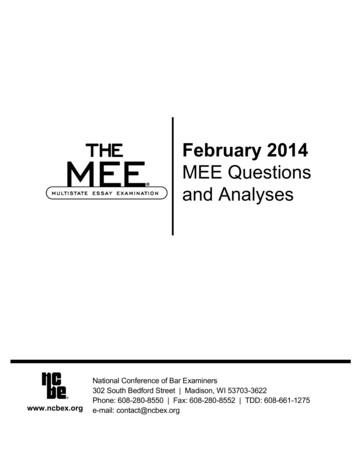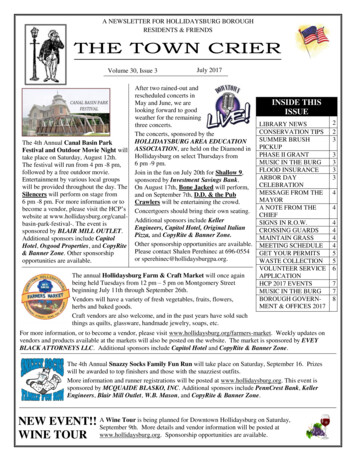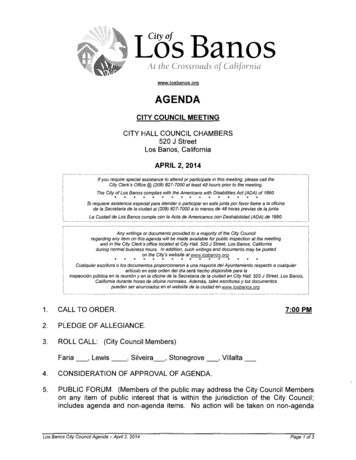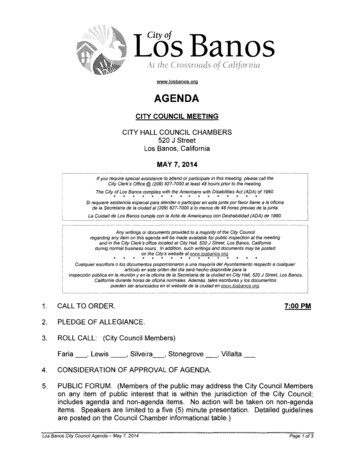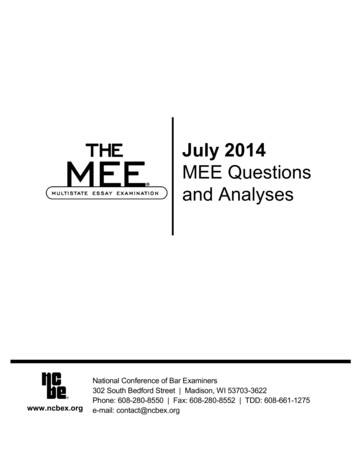
Transcription
July 2014MEE Questionsand Analyseswww.ncbex.orgNational Conference of Bar Examiners302 South Bedford Street Madison, WI 53703-3622Phone: 608-280-8550 Fax: 608-280-8552 TDD: 608-661-1275e-mail: contact@ncbex.org
Copyright 2014 by the National Conference of Bar Examiners.All rights reserved.
ContentsPreface.iiDescription of the MEE .iiInstructions.iiiJuly 2014 QuestionsCriminal Law and Procedure Question. .3Contracts Question. .5Family Law Question. .6Federal Civil Procedure Question . .7Evidence Question . .8Corporations Question . .9July 2014 AnalysesCriminal Law and Procedure Analysis . 13Contracts Analysis . 16Family Law Analysis . 19Federal Civil Procedure Analysis . 22Evidence Analysis. 27Corporations Analysis. 32i
PrefaceThe Multistate Essay Examination (MEE) is developed by the National Conference of BarExaminers (NCBE). This publication includes the questions and analyses from the July 2014MEE. (In the actual test, the questions are simply numbered rather than being identified by areaof law.) The instructions for the test appear on page iii.The model analyses for the MEE are illustrative of the discussions that might appear in excellentanswers to the questions. They are provided to the user jurisdictions to assist graders in gradingthe examination. They address all the legal and factual issues the drafters intended to raise in thequestions.The subjects covered by each question are listed on the first page of its accompanying analysis,identified by roman numerals that refer to the MEE subject matter outline for that subject. Forexample, the Federal Civil Procedure question on the July 2014 MEE tested the following areasfrom the Federal Civil Procedure outline: III., Injunctions and provisional remedies; and IV.C.,Pretrial procedures—Joinder of parties and claims (including class actions).For more information about the MEE, including subject matter outlines, visit the NCBE websiteat www.ncbex.org.Description of the MEEThe MEE consists of six 30-minute questions and is a component of the Uniform BarExamination (UBE). It is administered by user jurisdictions as part of the bar examination on theTuesday before the last Wednesday in February and July of each year. Areas of law that may becovered on the MEE include the following: Business Associations (Agency and Partnership;Corporations and Limited Liability Companies), Conflict of Laws, Constitutional Law,Contracts, Criminal Law and Procedure, Evidence, Family Law, Federal Civil Procedure, RealProperty, Torts, Trusts and Estates (Decedents’ Estates; Trusts and Future Interests), andUniform Commercial Code (Negotiable Instruments and Bank Deposits and Collections; SecuredTransactions). (Effective with the February 2015 MEE administration, Uniform CommercialCode Articles 3 and 4 [Negotiable Instruments and Bank Deposits and Collections] is no longerbeing tested.) Some questions may include issues in more than one area of law. The particularareas covered vary from exam to exam.The purpose of the MEE is to test the examinee’s ability to (1) identify legal issues raised by ahypothetical factual situation; (2) separate material which is relevant from that which is not; (3)present a reasoned analysis of the relevant issues in a clear, concise, and well-organizedcomposition; and (4) demonstrate an understanding of the fundamental legal principles relevantto the probable solution of the issues raised by the factual situation. The primary distinctionbetween the MEE and the Multistate Bar Examination (MBE) is that the MEE requires theexaminee to demonstrate an ability to communicate effectively in writing.ii
InstructionsThe back cover of each test booklet contains the following instructions:You will be instructed when to begin and when to stop this test. Do not break the seal on thisbooklet until you are told to begin.You may answer the questions in any order you wish. Do not answer more than one questionin each answer booklet. If you make a mistake or wish to revise your answer, simply draw aline through the material you wish to delete.If you are using a laptop computer to answer the questions, your jurisdiction will provide youwith specific instructions.Read each fact situation very carefully and do not assume facts that are not given in thequestion. Do not assume that each question covers only a single area of the law; some of thequestions may cover more than one of the areas you are responsible for knowing.Demonstrate your ability to reason and analyze. Each of your answers should show anunderstanding of the facts, a recognition of the issues included, a knowledge of the applicableprinciples of law, and the reasoning by which you arrive at your conclusions. The value ofyour answer depends not as much upon your conclusions as upon the presence and quality ofthe elements mentioned above.Clarity and conciseness are important, but make your answer complete. Do not volunteerirrelevant or immaterial information.Answer all questions according to generally accepted fundamental legal principles unlessyour testing jurisdiction has instructed you to answer according to local case or statutory law.NOTE: Examinees testing in UBE jurisdictions must answer according to generally acceptedfundamental legal principles rather than local case or statutory law.iii
July 2014 MEE QUESTIONSCriminal Law and ProcedureContractsFamily LawFederal Civil ProcedureEvidenceCorporations
CRIMINAL LAW AND PROCEDURE QUESTIONWhile on routine patrol, a police officer observed a suspect driving erratically and pulled thesuspect’s car over to investigate. When he approached the suspect’s car, the officer detected astrong odor of marijuana. The officer immediately arrested the suspect for driving under theinfluence of an intoxicant (DUI). While the officer was standing near the suspect’s car placinghandcuffs on the suspect, the officer observed burglary tools on the backseat.The officer seized the burglary tools. He then took the suspect to the county jail, booked him forthe DUI, and placed him in a holding cell. Later that day, the officer gave the tools he had foundin the suspect’s car to a detective who was investigating a number of recent burglaries in theneighborhood where the suspect had been arrested.At the time of his DUI arrest, the suspect had a six-month-old aggravated assault charge pendingagainst him and was being represented on the assault charge by a lawyer.Early the next morning, upon learning of her client’s arrest, the lawyer went to the jail. Shearrived at 9:00 a.m., immediately identified herself to the jailer as the suspect’s attorney, anddemanded to speak with the suspect. The lawyer also told the jailer that she did not want thesuspect questioned unless she was present. The jailer told the lawyer that she would need to waitone hour to see the suspect. After speaking with the lawyer, the jailer did not inform anyone ofthe lawyer’s presence or her demands.The detective, who had also arrived at the jail at 9:00 a.m., overheard the lawyer’s conversationwith the jailer. The detective then entered the windowless interview room in the jail where thesuspect had been taken 30 minutes earlier. Without informing the suspect of the lawyer’spresence or her demands, the detective read to the suspect full and accurate Miranda warnings.The detective then informed the suspect that he wanted to ask about the burglary tools found inhis car and the recent burglaries in the neighborhood where he had been arrested. The suspectreplied, “I think I want my lawyer here before I talk to you.” The detective responded, “That’s upto you.”After a few minutes of silence, the suspect said, “Well, unless there is anything else I need toknow, let’s not waste any time waiting for someone to call my attorney and having her drivehere. I probably should keep my mouth shut, but I’m willing to talk to you for a while.” Thesuspect then signed a Miranda waiver form and, after interrogation by the detective, madeincriminating statements regarding five burglaries. The interview lasted from 9:15 a.m. to10:00 a.m.In addition to the DUI, the suspect has been charged with five counts of burglary.The lawyer has filed a motion to suppress all statements made by the suspect to the detective inconnection with the five burglaries.The state supreme court follows federal constitutional principles in all cases interpreting acriminal defendant’s rights.3
Criminal Law and Procedure Question1.Did the detective violate the suspect’s Sixth Amendment right to counsel when hequestioned the suspect in the absence of the lawyer? Explain.2.Under Miranda, did the suspect effectively invoke his right to counsel? Explain.3.Was the suspect’s waiver of his Miranda rights valid? Explain.4
CONTRACTS QUESTIONA music conservatory has two concert halls. One concert hall had a pipe organ that was in poorrepair, and the other had no organ. The conservatory decided to repair the existing organ and buya new organ for the other concert hall. After some negotiation, the conservatory entered into twocontracts with a business that both repairs and sells organs. Under one contract, the businessagreed to repair the existing pipe organ for the conservatory for 100,000. The business wouldusually charge a higher price for a project of this magnitude, but the business agreed to this pricebecause the conservatory agreed to prepay the entire amount. Under the other contract, thebusiness agreed to sell a new organ to the conservatory for the other concert hall for 225,000.As with the repair contract, the business agreed to a low sales price because the conservatoryagreed to prepay the entire amount. Both contracts were signed on January 3, and theconservatory paid the business a total of 325,000 that day.Two weeks later, before the business had commenced repair of the existing organ, the businesssuffered serious and unanticipated financial reversals. The chief financial officer for the businesscontacted the conservatory and said,Bad news. We had an unexpected liability and as a result are in a real cash crunch. Infact, even though we haven’t acquired the new organ from our supplier or started repairof your existing organ, we’ve already spent the cash you gave us, and we have no freecash on hand. We’re really sorry, but we’re in a fix. I think that we can find a way toperform both contracts, but not at the original prices. If you agree to pay 60,000 morefor the repair and 40,000 more for the new organ, we can probably find financing tofinish everything. If you don’t agree to pay us the extra money, I doubt that we will everbe able to perform either contract, and you’ll be out the money you already paid us.After receiving this unwelcome news, the conservatory agreed to pay the extra amounts,provided that the extra amount on each contract would be paid only upon completion of thebusiness’s obligations under that contract. The business agreed to this arrangement, and theparties quickly signed documents reflecting these changes to each contract. The business thenrepaired the existing organ, delivered the new organ, and demanded payment of the additional 100,000.The conservatory now has refused to pay the business the additional amounts for the repair andthe new organ.1.Must the conservatory pay the additional 60,000 for the organ repair? Explain.2.Must the conservatory pay the additional 40,000 for the new organ? Explain.5
FAMILY LAW QUESTIONIn 1994, a man and a woman were married in State A.In 1998, their daughter was born in State A.In 2010, the family moved to State B.In 2012, the husband and wife divorced in State B. Under the terms of the divorce decree:(a) the husband and wife share legal and physical custody of their daughter;(b) the husband must pay the wife 1,000 per month in child support until their daughterreaches age 18;(c) the marital residence was awarded to the wife, with the proviso that if it is sold beforethe daughter reaches age 18, the husband will receive 25% of the net sale proceedsremaining after satisfaction of the mortgage on the residence; and(d) the remaining marital assets were divided between the husband and the wife equally.Six months ago, the husband was offered a job in State A that pays significantly less than his jobin State B but provides him with more responsibilities and much better promotion opportunities.The husband accepted the job in State A and moved from State B back to State A.Since returning to State A, the husband has not paid child support because, due to his lowersalary, he has had insufficient funds to meet all his obligations.One month ago, the wife sold the marital home, netting 10,000 after paying off the mortgage.She then moved to a smaller residence. The husband believes that he should receive more than25% of the net sale proceeds given his financial difficulties.Last week, when the wife brought the daughter to the husband’s State A home for a weekendvisit, the husband served the wife with a summons in a State A action to modify the support andmarital-residence-sale-proceeds provisions of the State B divorce decree. The husband broughtthe action in the State A court that adjudicates all domestic relations issues.1.Does the State A court have jurisdiction to modify(a)the child support provision of the State B divorce decree? Explain.(b)the marital-residence-sale-proceeds provision of the State B divorce decree?Explain.2.On the merits, could the husband obtain(a)retroactive modification of his child support obligation to the daughter? Explain.(b)prospective modification of his child support obligation to the daughter? Explain.(c)modification of the marital-residence-sale-proceeds provision of the State Bdivorce decree? Explain.6
FEDERAL CIVIL PROCEDURE QUESTIONThe United States Forest Service (USFS) manages public lands in national forests, including theScenic National Forest. Without conducting an environmental evaluation or preparing anenvironmental impact statement, the USFS approved a development project in the ScenicNational Forest that required the clearing of 5,000 acres of old-growth forest. The trees in theforest are hundreds of years old, and the forest is home to a higher concentration of wildlife thancan be found anywhere else in the western United States.The USFS solicited bids from logging companies to harvest the trees on the 5,000 acres of foresttargeted for clearing, and it ultimately awarded the logging contract to the company that hadsubmitted the highest bid for the trees. However, the USFS has not yet issued the company alogging permit. Once it does so, the company intends to begin cutting down trees immediately.A nonprofit organization whose mission is the preservation of natural resources has filed suit infederal district court against the USFS. The nonprofit alleges that the USFS violated the NationalEnvironmental Policy Act (NEPA) by failing to prepare an environmental impact statement forthe proposed logging project. Among other remedies, the nonprofit seeks a permanent injunctionbarring the USFS from issuing a logging permit to the logging company until an adequateenvironmental impact statement is completed. The nonprofit believes that the logging projectwould destroy important wildlife habitat and thereby cause serious harm to wildlife in the ScenicNational Forest, including some endangered species.Assume that federal subject-matter jurisdiction is available, that the nonprofit has standing tobring this action, and that venue is proper.1.If the logging company seeks to join the litigation as a party, must the federal districtcourt allow it to do so as a matter of right? Explain.2.What types of relief could the nonprofit seek to stop the USFS from issuing a loggingpermit during the pendency of the action, what must the nonprofit demonstrate to obtainthat relief, and is the federal district court likely to grant that relief? Explain.7
EVIDENCE QUESTIONA prison inmate has filed a civil rights lawsuit against a guard at the prison, alleging that theguard violated the inmate’s constitutional rights during an altercation. The inmate and the guardare the only witnesses to this altercation. They have provided contradictory reports about whatoccurred.The trial will be before a jury. The inmate plans to testify at trial. The guard’s counsel has movedfor leave to impeach the inmate with the following:(a) Twelve years ago, the inmate was convicted of felony distribution of marijuana. Heserved a three-year prison sentence, which began immediately after he was convicted. Heserved his full sentence and was released from prison nine years ago.(b) Eight years ago, the inmate pleaded guilty to perjury, a misdemeanor punishable byup to one year in jail. He paid a 5,000 fine.(c) Seven years ago, the inmate was convicted of felony sexual assault of a child and iscurrently serving a 10-year prison sentence for the crime. The victim was the inmate’sdaughter, who was 13 years old at the time of the assault.The inmate’s counsel objects to the admission of any evidence related to these three convictionsand to any cross-examination based on this evidence.The guard also plans to testify at trial. The inmate’s counsel has moved for leave to impeach theguard with the following:Last year, the guard applied for a promotion to prison supervisor. The guard submitted arésumé to the state that indicated that he had been awarded a B.A. in Criminal Justicefrom a local college. An official copy of the guard’s academic transcript from that collegeindicates that the guard dropped out after his first semester and did not receive a degree.The guard’s counsel objects to the admission of this evidence and to any cross-examinationbased on this evidence.The transcript and the résumé have been properly authenticated. The trial will be held in ajurisdiction that has adopted all of the Federal Rules of Evidence.1.What evidence, if any, proffered by the guard to impeach the inmate should be admitted?Explain.2.What evidence, if any, proffered by the inmate to impeach the guard should be admitted?Explain.8
CORPORATIONS QUESTIONMega Inc. is a publicly traded corporation incorporated in a state whose corporate statute ismodeled on the Model Business Corporation Act (MBCA). Mega’s articles of incorporation donot address the election of directors or amendment of the bylaws by shareholders.Well within the deadline for the submission of shareholder proposals for the upcoming annualshareholders’ meeting, an investor, who was a large and long-standing shareholder of Mega,submitted a proposed amendment to Mega’s bylaws. The proposal, which the investor asked tobe included in the corporation’s proxy materials and voted on at the upcoming shareholders’meeting, read as follows:Section 20: The Corporation shall include in its proxy materials (including the proxyballot) for a shareholders’ meeting at which directors are to be elected the name of aperson nominated for election to the Board of Directors by a shareholder or group ofshareholders that beneficially have owned 3% or more of the Corporation’s outstandingcommon stock for at least one year.This Section shall supersede any inconsistent provision in these Bylaws and may not beamended or repealed by the Board of Directors without shareholder approval.Mega’s management decided to exclude the investor’s proposal from the corporation’s proxymaterials and explained its reasons in a letter to the investor:The investor’s proposed bylaw provision would be inconsistent with relevant state lawbecause the Board of Directors has the authority to manage the business and affairs of theCorporation. Generally, shareholders lack the authority to interfere with corporatemanagement by seeking to create a method for the nomination and election of directorsinconsistent with the method chosen by the Board of Directors.Furthermore, at its most recent meeting, the Board of Directors unanimously approved anamendment to the Corporation’s bylaws that provides for proxy access for directornominations by a shareholder or a group of shareholders holding at least 10% of theCorporation’s voting shares for at least three years. This procedure takes precedence overany nomination methods that might be sought or approved by shareholders.The investor is considering bringing a suit challenging management’s refusal to include theinvestor’s proposed bylaw provision and challenging the board’s amendment of the bylaws at itsrecent meeting.1.Is the investor’s proposed bylaw provision inconsistent with state law? Explain.2.If the investor’s proposed bylaw provision were approved by the shareholders, would thebylaw amendment previously approved by the board take precedence over the investor’sproposed bylaw provision? Explain.3.Must the investor make a demand on Mega’s board of directors before bringing suit?Explain.9
July 2014 MEE ANALYSESCriminal Law and ProcedureContractsFamily LawFederal Civil ProcedureEvidenceCorporations
CRIMINAL LAW AND PROCEDURE ANALYSIS(Criminal Law and Procedure V.A., B., D.)ANALYSISLegal Problems(1) Did the detective violate the suspect’s Sixth Amendment right to counsel when hequestioned the suspect about the burglaries without the lawyer present, given that thelawyer represented the suspect in an unrelated criminal matter?(2) Under Miranda, did the suspect effectively invoke his right to counsel when he said,“I think I want my lawyer here before I talk to you”?(3) Was the suspect’s waiver of his right to remain silent under Miranda valid?DISCUSSIONSummaryThe Sixth Amendment right to counsel, as applied to states through the Fourteenth Amendment,is offense-specific. Although the suspect had an attorney representing him on his pending assaultcharge, he had no Sixth Amendment right to the assistance of counsel with respect to the fiveuncharged burglaries because formal adversarial proceedings had not yet commenced on thosecharges. The suspect’s Sixth Amendment right to counsel was not violated by the detective’sfailure to inform him that the lawyer was present or of the lawyer’s demands.However, a person undergoing custodial interrogation also has an independentconstitutional right to counsel during custodial interrogation under Miranda. When a suspectinvokes his right to counsel under Miranda, custodial interrogation must immediately cease for aperiod of at least 14 days. However, the invocation of the right to counsel must be unambiguousand clearly convey that the suspect has requested counsel. Here, because the suspect’s statement,“I think I want my lawyer here before I talk to you,” was ambiguous, he did not invoke hisMiranda right to counsel.A waiver of rights must be knowing, intelligent, and voluntary. Here, the suspect waivedhis right to remain silent under Miranda when he signed the waiver form. The fact that thedetective did not correct the suspect’s assumption that the lawyer would need to drive to thejail—by telling him that the lawyer was in the waiting room and was demanding to see him—didnot affect the validity of the suspect’s waiver.Point One (35%)The suspect’s Sixth Amendment right to counsel was not violated because the right does notattach on new charges until formal adversarial judicial proceedings have commenced on thosecharges.The Sixth Amendment, as applied to the states through the Fourteenth Amendment, provides that“[i]n all criminal prosecutions, the accused shall enjoy the right . . . to have the Assistance ofCounsel for his defense.” The right to counsel does not attach with respect to particular chargesuntil formal adversarial judicial proceedings have commenced (i.e., “at or after the initiation of13
Criminal Law and Procedure Analysisadversary judicial criminal proceedings—whether by way of formal charge, preliminary hearing,indictment, information, or arraignment [or in some states, arrest warrant],” McNeil v. Wisconsin,501 U.S. 171, 175 (1991) (internal quotations omitted)). Once a suspect’s Sixth Amendmentright to counsel has attached, any attempts to “deliberately elicit” statements from him in theabsence of his attorney violate the Sixth Amendment. See Massiah v. United States, 377 U.S.201 (1964); Brewer v. Williams, 430 U.S. 387 (1977).The Sixth Amendment right to counsel is charge- or offense -specific. Representation bycounsel in one prosecution does not, in itself, guarantee counsel for uncharged offenses. SeeMcNeil, 501 U.S. at 175; Texas v. Cobb, 532 U.S. 162 (2001). Here, the suspect’s SixthAmendment right to counsel had attached only for the pending aggravated assault charge. Thesuspect’s right to counsel for the aggravated assault case did not guarantee counsel for the fiveunrelated and uncharged burglaries that were the subject of the detective’s interrogation. Thus,because formal adversarial judicial proceedings against the suspect for the uncharged burglarieshad not begun, he had no Sixth Amendment right to counsel.Finally, the detective’s failure to inform the suspect of the lawyer’s presence anddemands to speak with him does not implicate the suspect’s Sixth Amendment right to counsel,which had not yet attached. See id.; Moran v. Burbine, 475 U.S. 412, 428–31 (1986).Point Two (30%)The suspect did not effectively invoke his right to counsel under Miranda because his statementwas not unambiguous.A suspect subject to custodial interrogation has a right to consult with counsel and to have anattorney present during questioning. Miranda v. Arizona, 384 U.S. 436 (1966). When a suspectinvokes his right to counsel during an interrogation, law enforcement must immediately cease allquestioning. See Edwards v. Arizona, 451 U.S. 477, 484–85 (1981). Custodial interrogationcannot be reinitiated unless and until the suspect has been re-advised of his Miranda rights, hasprovided a knowing and voluntary waiver, and (1) counsel is present and (2) the suspect himselfinitiated further communication with the police, see id. at 484, or (3) (if the suspect was releasedfrom custody after the initial interrogation) at least 14 days have passed. Maryland v. Shatzer,559 U.S. 98, 110 (2010).To invoke the right to counsel, a suspect’s request must be “unambiguous.” This meansthat the suspect must articulate the desire for counsel sufficiently clearly that a reasonable officerwould understand the statement to be a request for counsel. Davis v. United States, 512 U.S. 452,459 (1994). If the request is ambiguous, the police are not required to stop the interrogation.In this case, the suspect’s statement, “I think I want my lawyer here before I talk to you,”was not an unambiguous request for counsel. The most reasonable interpretation of thisstatement is that the suspect might be invoking his right to counsel. Id. at 461 (“maybe I shouldtalk to a lawyer” is not an unequivocal request for counsel). See also Burket v. Angelone, 208F.3d 172, 197–98 (4th Cir. 2000) (“I think I need a lawyer” is not an unambiguous request for anattorney); Soffar v. Cockrell, 300 F.3d 588, 594–95 (5th Cir. 2002) (discussion of variousstatements that did not constitute unequivocal requests for counsel).Under these circumstances, the detective was not required to cease the custodialinterrogation of the suspect. Nor was the detective required to clarify or ask follow-up questionsto determine whether the suspect in fact wanted an attorney. Davis, 512 U.S. at 459–60.14
Criminal Law and Procedure AnalysisPoint Three (35%)The suspect’s waiver of his Miranda rights was knowing, intelligent, and voluntary despite thefact that he was never told of the lawyer’s presence in the jail or of the lawyer’s demands.A valid waiver of Miranda rights must be “voluntary”—i.e., the product of a free or deliberatechoice rather than intimidation, coercion, or deception. Berghuis v. Thompkins, 560 U.S. 370,382–83 (2010). In addition, the waiver must be knowing and intelligent. That is, it “must havebeen made with a full awareness of both the nature of the right being abandoned and theconsequences of the decision to abandon it.” Moran v. Burbine, 475 U.S. 421 (1986).In this case, the suspect signed a Miranda waiver form after receiving proper warnings.There is no evidence “that the police resorted to physical or psychological pressure to elicit thestatements.” Id. The entire interview lasted only 45 minutes. The only issue is whether thesuspect knowingly and intelligently waived his Miranda rights despite the
This publication includes the questions and analyses from the July 2014 MEE. (In the actual test, the questions are simply numbered rather than being identified by area of law.) The instructions for the test appear on page iii. The model analyses for the MEE are illustrative of the discussions that might appear in excellent answers to the .

